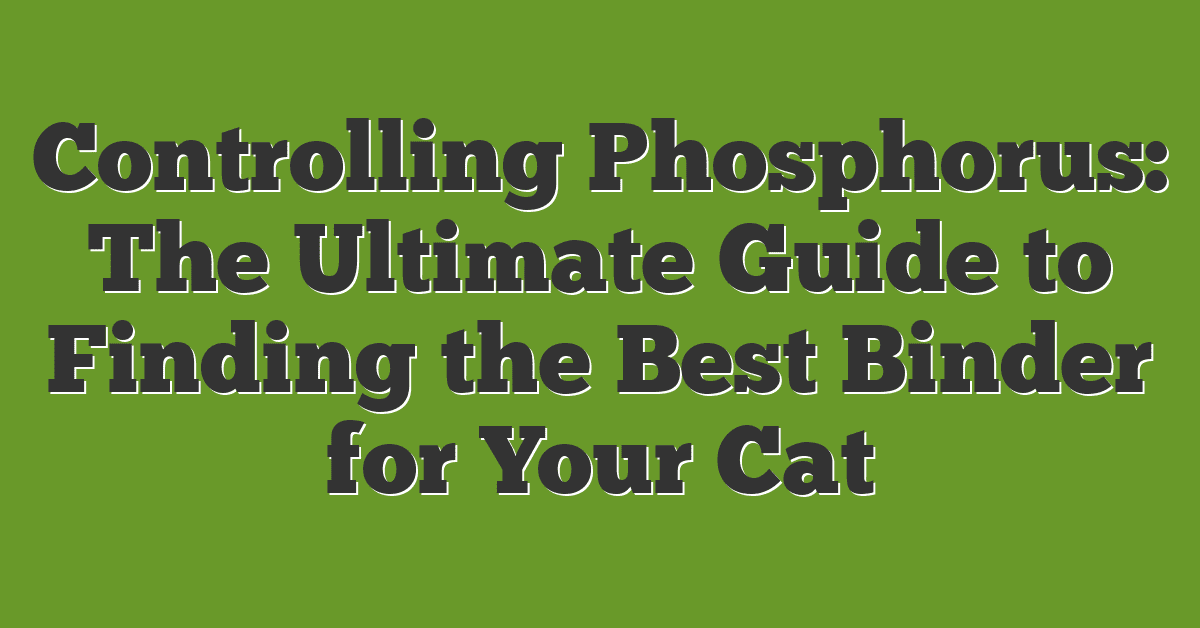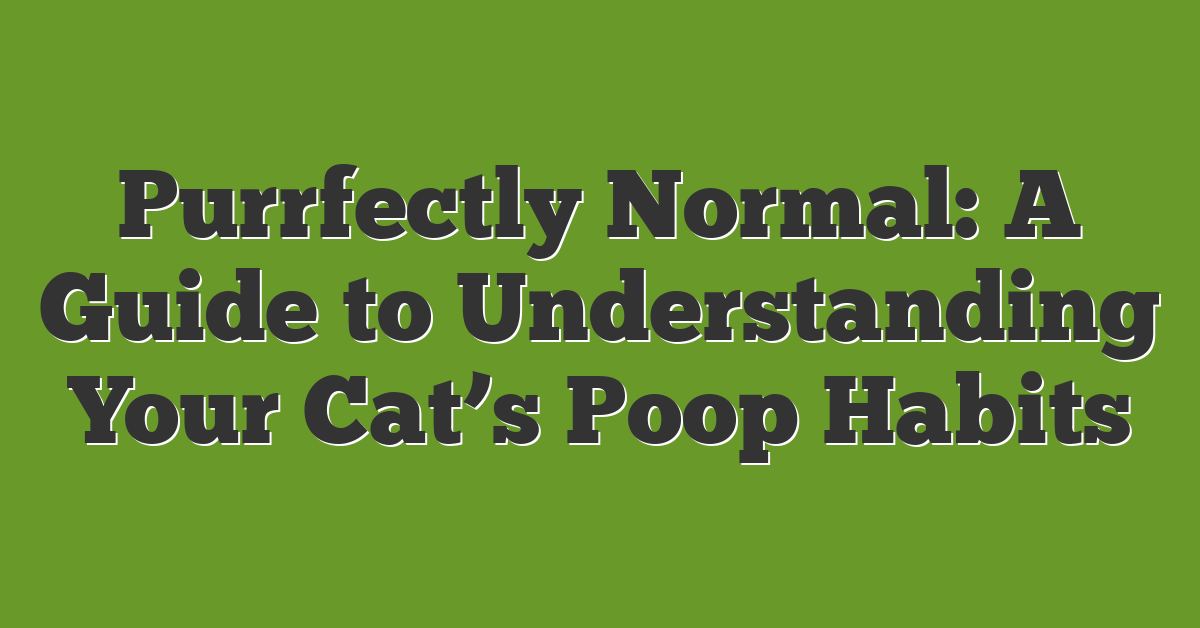If you’re dealing with a cat that has kidney disease, regulating their phosphorus intake is crucial. A phosphorus binder can be one of the best ways to manage their condition, but with so many options out there, how do you know which one to choose? In this article, we’ll explore the different types of binders available, their pros and cons, and various tips to help you manage your cat’s phosphorus. By the end of this article, you’ll feel confident in your ability to choose the best phosphorus binder for your furry friend.

Why Phosphorus Control is Important for Cats
Phosphorus is an essential mineral that plays a critical role in keeping cats healthy. However, too much phosphorus can be harmful, especially for cats with renal problems. Hyperphosphatemia, or high blood phosphorus levels, is commonly seen in cats with kidney disease or chronic kidney disease (CKD).
In cats with renal problems, the kidneys are compromised, causing them to lose the ability to properly filter out excess phosphorus. High levels of phosphorus can have a detrimental effect on the cat’s health, leading to a range of problems such as bone mineralization disorders, calcification of soft tissues, and reduced lifespan. While a low phosphorus diet can help, it may not be enough to manage the condition. This is where phosphorus binder therapy comes into play.
Phosphorus binders are medications that can help regulate the cat’s phosphorus levels. These binders work by binding with the excess phosphorus in food, preventing its absorption by the cat’s body. However, not all binders are created equal. The type of binder used can affect its effectiveness and potential side effects.
Understanding the different types of binders available on the market can help cat owners make an informed decision about which one is right for their feline companion. It is also essential to work closely with a veterinarian to monitor the cat’s phosphorus levels and adjust the dosage as necessary.
In the next section, we will explore the various types of binders available, their pros and cons, and which one may be the best for your cat.
Key Takeaways:
- Excess phosphorus can be harmful to cats with renal problems.
- Phosphorus binder therapy can help regulate the cat’s phosphorus levels.
- Understanding the different types of binders available and working closely with a veterinarian is essential for proper management.
The Different Types of Binders and How They Work
Cats with renal problems or chronic kidney disease (CKD) require careful monitoring of their phosphorus levels. Hyperphosphatemia, or elevated levels of phosphorus in the blood, can worsen kidney function and cause numerous health complications for your feline friend. Phosphorus binders are a crucial tool in controlling phosphorus levels in cats. However, the different types of binders and how they work can be confusing for cat owners.
Calcium-based Binders:
Calcium-based binders are the most commonly known and widely used for managing cat’s phosphorus levels. These binders primarily work by binding to phosphorus in your cat’s gastrointestinal tract, preventing its absorption. Common examples of calcium-based binders include calcium carbonate and calcium acetate. Calcium-based binders have several advantages, including being easily accessible and cost-effective. However, they are not always recommended for cats with higher calcium levels.
Non-Calcium-based Binders:
If your cat has elevated calcium levels, it might be necessary to avoid calcium-based binders and opt for non-calcium-based binders. Non-calcium-based binders, such as sevelamer, lanthanum carbonate, and iron-based binders, work similarly by binding to phosphorus. These binders are effective in reducing phosphorus levels, even when calcium levels are high. However, they are often more expensive and may be challenging to access.
Sucroferric Oxyhydroxide:
Sucroferric oxyhydroxide is another type of phosphorus binder and is an iron-based phosphate binder for cats. While sucroferric oxyhydroxide is a relatively new phosphate-lowering agent for cats, it has been proven to be highly effective in reducing phosphorus levels in CKD cats. Sucroferric oxyhydroxide works by binding with phosphorus in the gut, reducing its absorption and lowering serum phosphorus levels.
Ultimately, the type of binder you choose for your cat depends on several factors, such as your cat’s overall health, stage of CKD, and blood calcium and phosphorus levels. Consulting with your veterinarian is crucial in determining the best binder for your cat’s needs.
In the next section, we will explore tips for managing your cat’s phosphorus binder therapy, as well as prescription diets and other dietary strategies for managing phosphorus levels in cats.
Calcium-based Binders: Pros and Cons
Calcium-based binders are one type of phosphorus binder used to manage phosphorus levels in cats with renal problems or kidney disease. These binders work by binding to phosphorus in the intestinal tract, preventing its absorption and thus reducing the amount that enters the bloodstream. While they can be effective, there are both pros and cons to using calcium-based binders for your cat.
Pros:
Effective: Calcium-based binders are generally very effective at controlling phosphorus levels in cats. They work quickly and efficiently, which can be especially important in stabilizing a cat’s condition in the early stages of renal problems or kidney disease.
Easy to Administer: Calcium-based binders are usually available in the form of a tablet or powder, which can be easily mixed into your cat’s food. This makes them relatively easy to administer, especially compared to some of the other non-calcium-based binders.
Widely Available: Calcium-based binders are widely prescribed by veterinarians and are readily available from most pet stores and online retailers. This means that they are generally easy to find and obtain, which can be important if your cat’s condition requires prompt treatment.
Cons:
Potential for Hypercalcemia: One of the main drawbacks to using calcium-based binders is the potential for hypercalcemia, or high levels of calcium in the blood. This can lead to a range of health problems, including bone problems, digestive issues, and even damage to the kidneys themselves.
Interferes with Other Medications: Calcium-based binders can interfere with the absorption of other medications, making it important to separate doses by a few hours to prevent interactions.
Long-term Use Can Be Risky: Over time, long-term use of calcium-based binders can lead to the development of calcification or mineral deposits in various parts of the body. This can pose a potential risk of organ damage, especially if your cat has an existing health condition.
While calcium-based binders can be an effective option for controlling phosphorus levels in cats with renal problems or kidney disease, they are not without their drawbacks. It is important to discuss the pros and cons with your veterinarian to determine the best course of treatment for your cat’s individual needs.
Non-Calcium-based Binders: Which One is Right for Your Cat?
When it comes to phosphorus binder therapy for cats, there are several types of non-calcium-based binders that may be prescribed by your vet. Each binder works differently to regulate phosphorus levels, but how do you know which one is right for your cat? Here’s a breakdown of the most common non-calcium-based binders used in feline medicine:
Sevelamer: This binder is effective in reducing phosphorus levels in cats with chronic kidney disease (CKD) and hyperphosphatemia. It works by binding to the phosphorus in the intestines and preventing it from being absorbed into the bloodstream. Sevelamer does not contain aluminum, which can be a concern with other binders, but it may cause gastrointestinal side effects such as vomiting, diarrhea, and constipation.
Lanthanum Carbonate: Lanthanum carbonate is another non-calcium-based binder that is used to prevent the absorption of phosphorus in the intestines. It is often prescribed for cats with CKD and hyperphosphatemia. Unlike sevelamer, lanthanum carbonate is not absorbed by the body, which reduces the potential for toxicity. However, it may also cause gastrointestinal side effects such as vomiting and diarrhea.
Iron-based Binders: Iron-based binders work by binding to phosphorus in the gut and eliminating it from the body through the feces. They are often prescribed for cats with CKD and hyperphosphatemia. One commonly used iron-based binder is sucroferric oxyhydroxide. This binder is mixed with the cat’s food and may cause gastrointestinal side effects such as vomiting, diarrhea, and constipation.
It’s important to note that not all phosphorus binders are created equal, and what might work for one cat may not work for another. Your vet will determine the type of binder that is best suited for your cat’s individual needs based on factors such as their overall health, age, and underlying medical conditions.
In addition to non-calcium-based binders, there are also dietary strategies that can be used to manage your cat’s phosphorus levels. A low phosphorus diet, as prescribed by your vet, can help reduce the amount of phosphorus your cat consumes and lessen the need for binders. Special therapeutic foods may also be recommended, such as prescription diets specifically formulated for cats with renal problems.
To ensure the effectiveness of your cat’s binder therapy, it’s important to follow your vet’s instructions carefully and monitor your cat’s phosphorus levels regularly. By working together with your vet and implementing the appropriate dietary and medical interventions, you can help manage your cat’s phosphorus levels and improve their overall health and quality of life.
Tips for Managing Your Cat’s Phosphorus Binder Therapy
Controlling Phosphorus: The Ultimate Guide to Finding the Best Binder for Your Cat
If your feline friend has renal problems, kidney disease, or chronic kidney disease (CKD), your veterinarian may recommend a low phosphorus diet and phosphorus binder therapy. The goal of phosphorus control is to reduce hyperphosphatemia (high levels of phosphorus in the blood), which can worsen renal function and cause other health problems.
Phosphorus binders, also known as phosphate lowering agents, work by binding to excess phosphorus in the cat’s gastrointestinal tract and preventing its absorption. There are several types of phosphorus binders available, but not all of them are equally effective or safe for cats.
In this section, we’ll discuss some tips for managing your cat’s phosphorus binder therapy:
Follow your veterinarian’s instructions: Your vet will prescribe the best phosphorus binder for your cat’s individual needs and advise you on the appropriate dosage, frequency, and administration method. It’s important to follow these instructions carefully and not adjust the medication without consulting your vet first.
Monitor your cat’s response: Regular blood tests can help monitor your cat’s phosphorus levels and kidney function. If your cat’s phosphorus levels remain high or his creatinine levels increase, your vet may need to adjust the treatment plan or change the binder type.
Be consistent with feeding: Consistency is key when it comes to managing a low phosphorus diet and binder therapy. Make sure to feed your cat the same amount and type of food every day, and give the binder as directed with meals.
Watch for side effects: Some cats may experience gastrointestinal upset, such as nausea, vomiting, diarrhea, or constipation, when taking certain types of binders. If your cat seems unwell or has trouble taking the medication, let your vet know as soon as possible.
Consider using a prescription diet: Therapeutic foods, such as prescription diets, can also help control your cat’s phosphorus intake and support his kidney health. These diets are specially formulated to be low in phosphorus and high in quality protein, and may also contain other beneficial ingredients, such as omega-3 fatty acids, antioxidants, and B vitamins.
By following these tips and working closely with your veterinarian, you can help manage your cat’s phosphorus binder therapy and improve his quality of life.
Prescription Diets and Other Dietary Strategies for Managing Your Cat’s Phosphorus
If your cat has been diagnosed with chronic kidney disease (CKD) or has renal problems, there are several dietary strategies that can be implemented to help manage their phosphorus levels. One of the most effective methods of managing your cat’s phosphorus levels is by feeding them a low phosphorus diet.
Phosphorus is an essential mineral that is needed for many bodily functions. However, too much phosphorus in your cat’s diet can be harmful, especially if they have CKD. When the kidneys are not functioning properly, they are unable to excrete excess phosphorus from the body. This can lead to hyperphosphatemia, which is a condition in which there is too much phosphorus in the blood. Over time, this can cause damage to the kidneys and other organs.
One of the main goals of managing your cat’s phosphorus levels is to decrease their phosphate intake. This can be achieved by feeding them a diet that is low in phosphorus. Prescription diets that are specifically designed for cats with CKD are available and can be very helpful in managing phosphorus levels. These diets are designed to be nutritionally complete and balanced while also being low in phosphorus.
When selecting a prescription diet for your cat, it is important to consult with your veterinarian to determine which one is best for your cat’s specific needs. Your veterinarian may also recommend other dietary strategies, such as feeding your cat therapeutic food or a renal prescription diet.
Another dietary strategy that can be helpful in managing your cat’s phosphorus levels is to limit their consumption of high-phosphorus foods. This includes foods such as dairy products, meat, and fish. Instead, focus on feeding your cat foods that are low in phosphorus, such as fruits and vegetables.
In addition to dietary strategies, there are also supplements and phosphate-lowering agents that can be used to manage your cat’s phosphorus levels. Some of the most commonly used phosphorus binders include calcium-based binders, aluminum hydroxide, sevelamer, and lanthanum carbonate. These binders work by binding to the excess phosphorus in the digestive tract, which prevents it from being absorbed into the bloodstream.
Overall, the most effective way to manage your cat’s phosphorus levels is through a combination of dietary strategies and phosphorus binder therapy. By working closely with your veterinarian, you can develop a comprehensive treatment plan that is tailored to your cat’s specific needs. With the right management, your cat can live a happy and healthy life despite their renal problems.

















